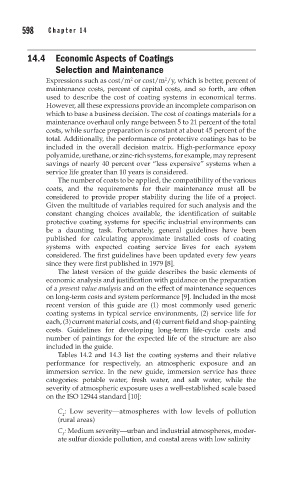Page 635 - Corrosion Engineering Principles and Practice
P. 635
598 C h a p t e r 1 4 P r o t e c t i v e C o a t i n g s 599
14.4 Economic Aspects of Coatings
Selection and Maintenance
Expressions such as cost/m or cost/m /y, which is better, percent of
2
2
maintenance costs, percent of capital costs, and so forth, are often
used to describe the cost of coating systems in economical terms.
However, all these expressions provide an incomplete comparison on
which to base a business decision. The cost of coatings materials for a
maintenance overhaul only range between 5 to 21 percent of the total
costs, while surface preparation is constant at about 45 percent of the
total. Additionally, the performance of protective coatings has to be
included in the overall decision matrix. High-performance epoxy
polyamide, urethane, or zinc-rich systems, for example, may represent
savings of nearly 40 percent over “less expensive” systems when a
service life greater than 10 years is considered.
The number of coats to be applied, the compatibility of the various
coats, and the requirements for their maintenance must all be
considered to provide proper stability during the life of a project.
Given the multitude of variables required for such analysis and the
constant changing choices available, the identification of suitable
protective coating systems for specific industrial environments can
be a daunting task. Fortunately, general guidelines have been
published for calculating approximate installed costs of coating
systems with expected coating service lives for each system
considered. The first guidelines have been updated every few years
since they were first published in 1979 [8].
The latest version of the guide describes the basic elements of
economic analysis and justification with guidance on the preparation
of a present value analysis and on the effect of maintenance sequences
on long-term costs and system performance [9]. Included in the most
recent version of this guide are (1) most commonly used generic
coating systems in typical service environments, (2) service life for
each, (3) current material costs, and (4) current field and shop-painting
costs. Guidelines for developing long-term life-cycle costs and
number of paintings for the expected life of the structure are also
included in the guide.
Tables 14.2 and 14.3 list the coating systems and their relative
performance for respectively, an atmospheric exposure and an
immersion service. In the new guide, immersion service has three
categories: potable water, fresh water, and salt water, while the
severity of atmospheric exposure uses a well-established scale based
on the ISO 12944 standard [10]:
C : Low severity—atmospheres with low levels of pollution
2
(rural areas)
C : Medium severity—urban and industrial atmospheres, moder-
3
ate sulfur dioxide pollution, and coastal areas with low salinity

